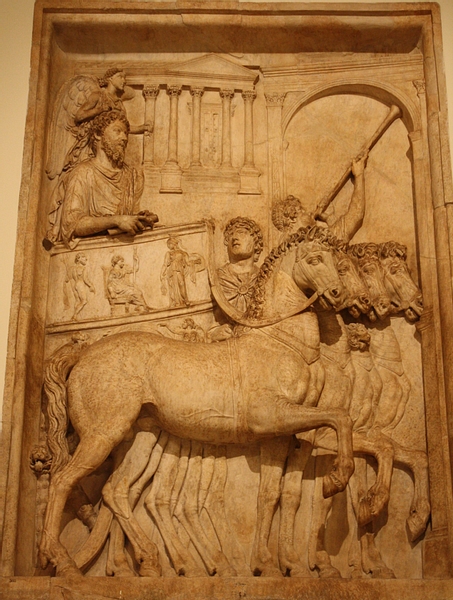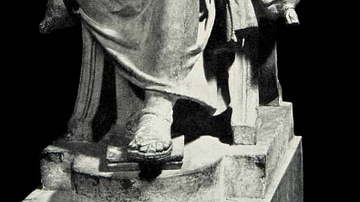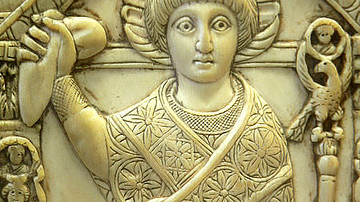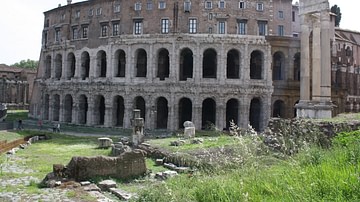
A Roman triumph was a spectacular celebration parade held in the ancient city of Rome for a military commander who had won an important victory on the battlefield. Granted by the Senate, it was a lavish and entertaining propaganda spectacle which reminded the people of the glory of Rome and its military superiority above all other nations.
Later, as triumphs became so popular and important in the ambitions of commanders, they were reserved for the emperor only. Over time, the processions became ever more extravagant as sometimes highly unpopular rulers sought to ingratiate themselves with the people of Rome by putting on an unforgettable show.
Ancient Sources
Many triumphs, as they were so important to political life and were celebrated over such a long period, were well documented by the Romans, even if later sources were keen to impress the royal household and so are prone to exaggeration. Initially, triumphs were for any senior commander who had performed great military deeds (or been in overall command of those subordinate officers who had) and who had brought his army back to Rome, but in the late Republic rules were often bent, and in the imperial period the privilege became less frequent. This was because the emperor, concerned to keep public affection for himself, made the parade exclusively the right of the royal household.
According to the 5th-century CE historian Orosius, there were 320 triumphs in Rome up to the 1st century CE. We also have a fragmentary list (part of the Fasti Triumphales) of all the Republic's triumphs, which probably first appeared on the 20 BCE Arch of Augustus in the Roman Forum. Regardless of exactly how many there were, though, when the city did host a triumph it must have been one of the most impressive sights the citizens would see in a city by no means short of entertaining spectacles.
Republican Triumphs
Roman historians describe even the early kings as celebrating triumphs, but this is likely pure fiction. The procession may have originally been an entirely religious one (and it did always maintain a religious element) involving the offering of foodstuffs to the fertility god Liber to ensure a good harvest. It may also have been a tradition borrowed from the Etruscans, but evidence is lacking.
The first celebrations of Roman military victories were doubtless much more modest and direct, but from the Punic Wars, a general procedure came to be established. First, a commander might receive from his legions a shouting ovation that he had earned the honorary title of imperator. The general would then send a tablet and laurel wreath (symbolic of victory at the great Olympic Games since the Archaic Period), known as a litterae laureatae, to the Roman senate. If the senate confirmed the victory and its importance his salutatio imperatoria was likewise confirmed. The commander now had the right to attach laurels to his fasces (the bundle of rods and axe which were the symbol of magisterial authority) and call himself, as an honorary title, Imperator. This he could do until the end of his public triumph (should he be granted one) or until he crossed the Pomerium, the sacred boundary of the city of Rome.
The next step was for the commander to go to Rome in person and wait outside the Pomerium. There he would carry his auspicia militaria, the auspices given to him by the city before his campaign. They could only be returned within the city on the day of his public triumph which he now had to petition the Senate for. Rather than the commander going to the Senate, they came to him and convened in the temple of Bellona to hear his claim. Sometimes there would be much debate, but a charismatic leader considered popular with the people and with influential friends always had a good chance of getting his triumph.
The triumph ceremonies varied each time but many common elements are evident. They generally took up a whole day and started with a speech before breakfast. The victorious commander would speak before the senate, magistrates, his army, and the public. The crowd would first salute him, then after appropriate prayers of thanks had been offered to the gods, he would praise his legions and mention specific individuals for their contributions, give out decorations for valour, and distribute money to his soldiers.
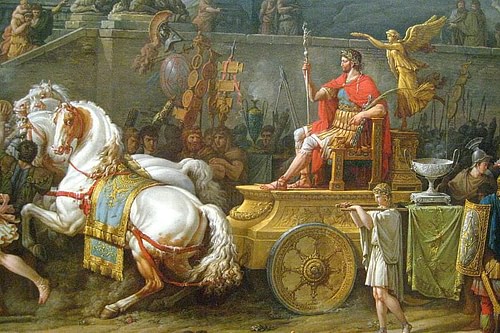
After breakfast, the victor put on special purple-coloured robes and offered sacrifices to the gods. He was ready for his big moment. The procession entered the city at a specific point, the Porta Triumphalis, a gate used only for that purpose, and then went through the streets and squares of Rome along a route chosen by the commander. The consuls and politicians would lead, followed by a number of impressive-looking captives from the battlefield – best of all would be a captured royal, perhaps theatrically enchained. Certain episodes of the battle might be represented in the procession via paintings or even enactments involving real captives. If the occasion was marking a naval triumph there might be a nautical theme going on with ships' beaks and captured equipment. There were musicians, torch-bearers, and flag wavers to add to the pageantry, as well as examples of the exotic flowers and animals from the conquered region. Next came the war-booty with the more gold and silver on display the better. After that came the lictors (magisterial attendants) who carried the fasces decked with laurel leaves and then the commander himself.
Star of the show, the god-like victor would ride a spectacular tall-sided chariot pulled by four horses. He wore a laurel crown and carried a laurel branch in his right hand. In his left hand, he carried an ivory sceptre with an eagle at the top, symbolic of the triumph. He was accompanied by a slave whose job was to hold above his head a gold crown and continuously whisper in his ear that, amongst all this adoration, he should remember that he was only a mortal and not actually a god. For this reason, he would repeat respice or 'look behind'. After the chariot came the commander's children and officers on horseback. Finally came the troops, who usually sang songs to ward off the jealousy of the gods, and, if there had been any, a crowd of grateful civilians who had won their freedom by the defeat of their enemy in the battle.
When the whole procession reached the temple of Jupiter Optimus Maximus on the Capitoline Hill the commander imperator might magnanimously free a prisoner or two (in the imperial period they were usually killed in the Forum prison en route) and then sacrificed a bull and offered some of the war-booty in honour of Jupiter. He also offered some of his laurel leaves and thus completed the cycle which had begun with his oath of duty before he had set off on campaign. Finally, the VIP guests sat down to a big banquet inside the temple; from the late Republican period a feast might be offered to the general populace too. After the party, a crowd would make sure the commander got home safe and sound after his big day.
Ovations
One level down from a triumph was an ovation. This was awarded for victories over easy opponents (fewer than 5,000 casualties) or those deemed lacking in honour such as pirates or slave revolts. The awarding of a mere ovation to Marcus Licinius Crassus after he quelled the Spartacus revolt is an example. An ovation was considered more appropriate for indecisive battles too. Some of the key differences, apart from having less prestige and pomp, were that the commander did not ride a chariot but travelled on horseback or even on foot, soldiers often did not participate, and a sheep was sacrificed at the end of the procession, not a bull. The commander's dress was not particularly special either as he wore the robe of a magistrate and a crown of myrtle, not laurel. Sometimes commanders, after being refused public money and the right to hold an ovation or triumph proper by the Senate, staged their own, smaller scale version on the Alban Mount. There were also one or two people who tried to stage a triumph outside Rome – Albucius in 104 BCE held one in Sardinia and Mark Antony in 34 BCE at Alexandria – but these were considered to be in very poor taste by the ruling elite in Rome.
Imperial Triumphs
As time went on, each triumph became grander than its predecessor and the whole event could spread over several days. This was especially so when commanders like Julius Caesar in 46 BCE and Octavian in 29 BCE actually celebrated multiple triumphs over successive days. Pompey must take credit for ramping up the spectacle as he had three triumphs in 80, 71, and 61 BCE, each more eye-popping than the last. A master of commemorative propaganda, he even went so far as to build Rome's first stone theatre to make sure his glory lived on for centuries to come. Julius Caesar went one better and built a whole forum, and thereafter, funding building work from the spoils of victory became common practice.
It would be Augustus, though, Rome's first emperor, who had the longest-lasting effect on the institution as he ensured that only the imperial family could bask in the public glory of a triumph. The last non-royal triumph was that of Cornelius Balbus in 19 BCE for his campaigns in Africa, and when Marcus Agrippa actually turned down a triumph in 14 BCE, that more or less set the precedent that this greatest of Roman honours was now a whole lot more exclusive. Augustus instead offered victorious commanders the possibility to wear a laurel crown when they attended games, something which had long been a privilege of those who had received a triumph in the Republican era.
The triumph of Vespasian and his son Titus in 71 CE for their victory in Judaea was notable for its flashy display of the riches from the temple at Jerusalem but, thereafter, triumphs became rare events, fewer than 20 perhaps in the next 200 years. Records are patchy for triumphs in the imperial period but we know that one of the last may have been in 303 CE for Diocletian and Maximian, following their victories in Africa and Britain. Some historians regard the last triumph as that of Belisarius who defeated the Persians and Vandals but that procession was held in Constantinople, not Rome.
In another development in the imperial period triumphs, when they were celebrated at all, they were sometimes done for mere political reasons rather than as marks of military success. In addition, the building of monumental arches became the ultimate, and more long-lasting, way for rulers to commemorate their military victories and personal contribution to the greatness of Rome. A wise decision perhaps, as of all the Romans' buildings, these arches are some of the best surviving monuments of Roman vanity, and they still dominate the urban landscape of many a modern city even after 2,000 years.
